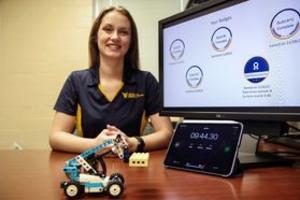In today’s fast-paced world, where monotony and repetitive tasks can dampen productivity and motivation, researchers are exploring innovative approaches to enhance workplace performance. A groundbreaking study from West Virginia University sheds light on the transformative potential of gamification—a concept that integrates game-like elements into everyday work activities. Led by industrial engineer Makenzie Dolly and her colleagues, the research demonstrates how gamification can drive results, improve employee engagement, and elevate productivity in manufacturing tasks. This article delves into the findings of the study, exploring the nuances of gamification and its impact on workers’ well-being and performance.
Understanding Gamification: Gamification involves the application of game design principles and mechanics to non-game contexts, such as work environments. By incorporating elements such as competition, rewards, and progress tracking, gamification seeks to motivate individuals and enhance their overall experience of performing tasks. From fitness tracking challenges to loyalty programs in marketing, gamification has permeated various aspects of modern life, offering a dynamic approach to engaging individuals and driving behavior change.
The Study Design: The research conducted by Makenzie Dolly and her team focused on the gamification of manufacturing tasks, particularly in assembly line settings. Using a toy Lego set to simulate the monotony of assembly tasks, participants were randomly assigned to either a gamified group or a control group. Both groups were tasked with assembling a Lego model of a telehandler—a repetitive and rote task akin to typical production assembly activities. However, participants in the gamified group had their productivity measured and rewarded using game-like elements such as progress bars and badges.
Key Findings and Insights: The study revealed compelling insights into the effects of gamification on employee motivation, productivity, and well-being. Participants in the gamified group demonstrated significantly improved productivity compared to their counterparts in the control group, indicating the efficacy of gamification in enhancing task performance. However, the researchers also observed an unexpected increase in participants’ stress levels within the gamified group, challenging conventional assumptions about the impact of gamification on perceived workload.
Navigating the Complexities of Gamification: While gamification holds promise as a tool for driving performance and engagement, it is essential to recognize the nuanced dynamics at play. The study findings suggest that the psychological load imposed by gamification can both motivate and stress workers, depending on individual characteristics and preferences. Factors such as personality traits, tolerance for challenge, and perceived task difficulty play a critical role in shaping employees’ responses to gamified tasks.
Optimizing Gamification Strategies: To maximize the benefits of gamification while mitigating potential drawbacks, organizations must adopt a tailored approach that aligns with employees’ preferences and work preferences. Understanding individual differences in personality, motivation, and stress tolerance is essential for designing effective gamification interventions. Moreover, incorporating feedback mechanisms and flexibility into gamified systems can empower employees to manage their workload and optimize their performance.
Balancing Challenge and Support: The success of gamification initiatives hinges on striking a delicate balance between challenge and support. While introducing elements of competition and rewards can spur motivation and engagement, it is crucial to avoid excessive stress and burnout. Employers must prioritize employee well-being and create a supportive work environment that encourages growth, resilience, and creativity. By fostering a culture of continuous improvement and learning, organizations can harness the full potential of gamification to drive sustainable performance gains.
As workplaces continue to evolve in response to technological advancements and changing workforce dynamics, the role of gamification in shaping employee experiences will become increasingly prominent. By embracing innovative approaches to motivation and engagement, organizations can cultivate a culture of excellence and innovation. The study conducted by Makenzie Dolly and her team offers valuable insights into the complexities of gamification and underscores the importance of thoughtful implementation and ongoing evaluation. As we navigate the future of work, let us harness the power of gamification to unlock human potential and drive collective success.
